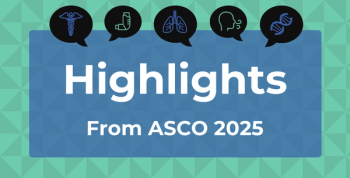
- August 2025
- Volume 31
- Issue Spec. No. 9
- Pages: SP588-SP589
For Better Cancer Outcomes, It’s All About Access
Key Takeaways
- Collaboration between oncologists and pharmacists is crucial for optimizing value-based oncology care and overcoming access barriers to therapies and tests.
- Enhancing access to biomarker testing and addressing payer reluctance are essential for equitable lung cancer care, with a focus on avoiding inappropriate therapies.
New drugs aren't the only advances in oncology. Innovation includes collaboration between to remove barriers to remove barriers to care, according to experts who gathered for a session of the Institute for Value-Based Medicine in Arlington, Virginia.
Advances in oncology extend beyond bringing new drugs to market. True innovation in cancer care involves strategic collaboration between oncologists and pharmacists, as well as identifying operational- and policy-level barriers to equitable access to both therapies and tests needed to guide care.
Leaders from health systems in and around Washington, DC, gathered to discuss these challenges at a session of the Institute for Value-Based Medicine held in Arlington, Virginia. Experts offered updates on ways industry leaders are working to drive the future of cancer care in a direction that offers patients both value and access.
Collaborating With Your Pharmacist to Optimize Value in Oncology
As oncology care continues to evolve toward value-based delivery, the role of pharmacists in multidisciplinary care teams has become critical, according to pharmacists who joined the first discussion. Moderated by Connor Flynn, PharmD, BCOP, clinical pharmacy specialist, University of Maryland Medical System, the panel featured Jody Agena, PharmD, MBA, director of pharmacy operations, Virginia Cancer Specialists; Humam Alkhaled, PharmD, clinical pharmacist, MedStar Georgetown University Hospital; Minhee Kang, PharmD, BCPS, BCOP, manager of oncology/research pharmacy, MedStar Georgetown University Hospital; and Raymond Lake, MS, RPh, corporate director of pharmacy operations, MedStar Health.
The group examined how pharmacy departments are pursuing innovative outpatient delivery models to make bispecific antibodies and chimeric antigen receptor (CAR) T-cell therapy more widely available, with a focus on reducing costs.
Panelists discussed strategies for integrating toxicity management across inpatient and outpatient workflows, ensuring seamless care despite increasing site-of-care mandates and fragmented models. Especially with CAR T-cell therapy, patients and caregivers must watch for signs of cytokine release syndrome (CRS) and immune effector cell–associated neurotoxicity syndrome (ICANS).
“We do know that [with] management of these toxicities, the big thing about them is to be in the hospital so we can move very [quickly] as soon as a patient exhibits any symptoms or signs for the CRS and ICANS,” Alkhaled said. “But if we have a model [for] outpatients that can move as quickly as the inpatient [model] in managing these patients, and as robust as the inpatient, I think we can do that safely.”
The conversation also highlighted the critical role of real-world data in assessing long-term outcomes and informing cost-effective, value-based decisions.
Panelists shared best practices and successful pharmacy service models that demonstrate measurable impact in enhancing patient care and operational efficiency.
“We wanted to see how we can actually save [pharmacists’] time so they can do more of their own work—either extending their knowledge or expanding their role—by freeing up time to do more,” Kang said. “That way, this multidisciplinary, collaborative action in the clinic will really bring good value to the whole cancer care workflow.”
Improving Access to Targeted and Immuno-Oncology Therapies in Lung Cancer
The second panel was moderated by Vincent Lam, MD, associate professor of oncology, Johns Hopkins University School of Medicine. The panelists included Neel Belani, MD, MBA, medical oncologist, Virginia Cancer Specialists; Stefanie Houseknecht, PharmD, BCOP, clinical pharmacy specialist, ambulatory thoracic malignancies, Johns Hopkins Bayview Medical Center; and Aliyah Pabani, MD, MPH, assistant professor of oncology, Sidney Kimmel Comprehensive Cancer Center.
Panelists explored how to improve early diagnosis and expand equitable access to biomarker testing in both non–small cell lung cancer and small cell lung cancer, particularly in early-stage disease where positive results can influence eligibility for perioperative immunotherapy. They also discussed payer reluctance to reimburse for retesting and the need for policy shifts as new targets and therapies emerge.
“I think we need payers to understand the value of avoiding inappropriate therapies,” Houseknecht said. “We want to ensure we’re not giving treatments that patients won’t benefit from. It’s not just about matching the right therapy; it’s also about avoiding therapies that could cause harm or offer no clinical benefit. The more we can emphasize that and show that biomarker-matched therapies lead to improved outcomes, the more payers will recognize the value of that approach.”
The conversation also examined evolving immunotherapy strategies, including the optimal duration of treatment, the relative benefits of neoadjuvant vs adjuvant use, and decision-making to stop therapy due to immune-related adverse events. Lastly, the panelists highlighted how financial and systemic barriers, such as insurance coverage, geographic location, and socioeconomic status, drive disparities in access to biomarker testing and advanced therapies and shared potential solutions to promote more equitable lung cancer care.
“Finding a way to standardize this across academic centers and various community practices is really important,” Pabani said. “The landscape is changing so quickly that it feels dizzying—even for those of us who treat just lung cancer. When I think about community oncologists who are managing multiple tumor types, it’s a huge challenge for them to keep up with all the rapidly evolving data.”
Rethinking Therapy, Access, and Value in Malignant Hematology
Multiple barriers hinder equitable access to advanced care in hematology, from clinical challenges in adopting novel therapies and minimal residual disease–guided care to operational- and policy-level obstacles. Experts Kieron Dunleavy, MBBS, MD, section chief, hematology, disease group lead, malignant hematology, MedStar Georgetown University Hospital; and Jean Yared, MD, medical director, clinical operations and ambulatory services, University of Maryland Medical Center, discussed how disparities in access can delay the benefits of scientific progress for underserved populations.
They outlined strategies to accelerate the integration of innovation into routine practice.
Strategies such as expanding community partnerships, developing outpatient treatment models, and pursuing payer reforms are essential steps toward ensuring access to trials for all patients. “I think there’s a challenge at the moment in terms of how to bridge that gap if [National Institutes of Health] funding is diminished, and what types of partnerships could help to bridge that gap,” Dunleavy said. What kinds of public [or] private partnerships could we think about?”
Both speakers emphasized the need for targeted investments in regulatory reform, collaborative trial networks, and real-world evidence generation to close the gap between scientific discovery and clinical implementation.
“We definitely have a big gap in this knowledge, and our constant dilemma in the clinic is when we [should] escalate treatment,” Yared said. “Which patient do I decide to consolidate with a transplant, and which patient do I de-escalate?”
No Outcome Without Access: Rewriting the Rules of Equity
The final discussion of the evening was a fireside chat with Nicolas Ferreyros, managing director, Community Oncology Alliance; and M. Adham Salkeni, MD, FRCPC, medical oncologist, Virginia Cancer Specialists.
This discussion highlighted education as the cornerstone of cancer prevention, with success seen in reducing tobacco- and hepatitis B virus–related cancers. Mobile screening programs were praised for improving access, though challenges remain in early detection, especially for rising colorectal cancer cases in younger adults. Barriers to diagnosis, such as limited access to PET scans and insurance denials, were also discussed. Key treatment priorities included expanding access to standard therapies, early palliative care, and more diverse clinical trial participation.
“It really is a multidisciplinary effort,” Salkeni said. “One party cannot do it all by itself. You have to involve not just the provider but [also] the patients. You’ve got to make sure that it’s a mutual decision-making process.”
The conversation also touched on value-based insurance design and financial toxicity; both speakers said there is an urgent need to reform a system burdened by intermediaries such as pharmacy benefit managers (PBMs), as well as complex pricing structures that limit access to affordable care.
Lastly, the discussion on cancer care equity in the US and Canada highlighted key structural challenges in both systems. In Canada, universal health care does not extend to prescription drug coverage, creating a significant gap that contributes to financial toxicity for patients. In contrast, the US system offers access to innovative, cutting-edge treatments but operates within a complex and fragmented framework that is heavily influenced by intermediaries like PBMs.
“I don’t think our problem is the inability to pay for things,” Ferreyros said. “I think our problem is that we’ve created a system so disintermediated—with PBMs, insurers, and all this muck in the middle—that CVS is now a Fortune 4 company in this country. Not Fortune 40, not Fortune 400—Fortune 4. It’s not because they sell toothbrushes. It’s because they’re a PBM, and that’s not right.
“What value do they bring?” he continued. “They don’t make the drug, [and] they don’t take care of the patient. What are they doing in the system? Sure, they negotiate prices, but how does that make them a Fortune 4, multibillion-dollar company in this country?”
The conversation made clear that neither country has fully solved the challenge of equitable cancer care, with both countries facing distinct limitations that impact access, affordability, and outcomes.
Articles in this issue
Newsletter
Stay ahead of policy, cost, and value—subscribe to AJMC for expert insights at the intersection of clinical care and health economics.







































